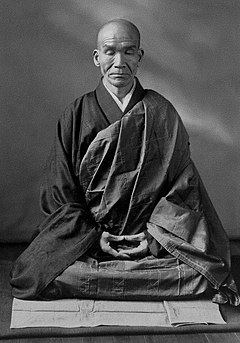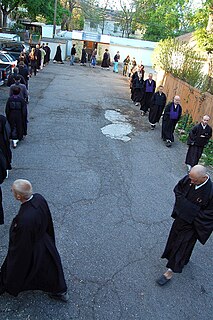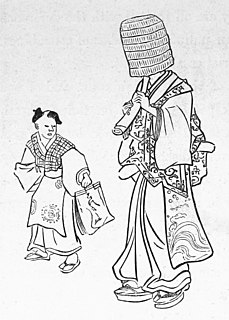
Zazen is a meditative discipline that is typically the primary practice of the Zen Buddhist tradition. The meaning and method of zazen varies from school to school, but in general it can be regarded as a means of insight into the nature of existence. In the Japanese Rinzai school, zazen is usually associated with the study of koans. The Sōtō School of Japan, on the other hand, only rarely incorporates koans into zazen, preferring an approach where the mind has no object at all, known as shikantaza.

Walking meditation, also known as kinhin is a practice within several forms of Buddhism that involve movement and periods of walking between long periods of sitting meditation. In different forms, the practice is common in Zen, Chan Buddhism, Korean Seon and Vietnamese Thiền. To perform walking meditation first find a location that is quiet. Start walking at a slow pace, walk 10-15 steps, back and forth. Put the hands and arms in a comfortable position. When walking, focus the attention on breathing, and balance the movement of the body: legs, neck, shoulders. While focusing, let the mind wander. The duration of walking meditation is about 10 minutes.
Sōtō Zen or the Sōtō school is the largest of the three traditional sects of Zen in Japanese Buddhism. It is the Japanese line of the Chinese Cáodòng school, which was founded during the Tang dynasty by Dòngshān Liánjiè. It emphasizes Shikantaza, meditation with no objects, anchors, or content. The meditator strives to be aware of the stream of thoughts, allowing them to arise and pass away without interference.

Pure Land Buddhism, also referred to as Amidism in English, is a broad branch of Mahayana Buddhism and one of the most widely practiced traditions of Buddhism in East Asia. Pure Land is a tradition of Buddhist teachings that are focused on the Buddha Amitābha. The three primary texts of the tradition, known as the "Three Pure Land Sutras", are the Longer Sukhāvatīvyūha Sūtra, Amitayurdhyana Sutra and the Shorter Sukhāvatīvyūha Sūtra.

A sesshin is a period of intensive meditation (zazen) in a Zen monastery.
Buddhism in the West broadly encompasses the knowledge and practice of Buddhism outside of Asia in the Western world. Occasional intersections between Western civilization and the Buddhist world have been occurring for thousands of years. The first Westerners to become Buddhists were Greeks who settled in Bactria and India during the Hellenistic period. They became influential figures during the reigns of the Indo-Greek kings, whose patronage of Buddhism led to the emergence of Greco-Buddhism and Greco-Buddhist art. There was little contact between the Western and Buddhist cultures during most of the Middle Ages but the early modern rise of global trade and mercantilism, improved navigation technology and the European colonization of Asian Buddhist countries led to increased knowledge of Buddhism among Westerners. This increased contact led to various responses from Buddhists and Westerners throughout the modern era. These include religious proselytism, religious polemics and debates, Buddhist modernism, Western convert Buddhists and the rise of Buddhist studies in Western academia. During the 20th century, there was a growth in Western Buddhism due to various factors such as immigration, globalization, the decline of Christianity and increased interest among Westerners. The various schools of Buddhism are now established in all major Western countries making up a small minority in the United States, Europe, Australia and New Zealand.
The Rinzai school is one of three sects of Zen in Japanese Buddhism.

Fuke-shū or Fuke Zen was a distinct and ephemeral derivative school of Japanese Zen Buddhism which originated as an offshoot of the Rinzai school during the nation's feudal era, lasting from the 13th century until the late 19th century. The sect, or sub-sect, traced its philosophical roots to the eccentric Zen master Puhua, as well as similarities and correspondences with the early Linji House and previous Chán traditions—particularly Huineng's "Sudden Enlightenment" —in Tang Dynasty China.

Buddhism, once primarily practiced in Asia, is now also practiced in the United States. As Buddhism does not require any formal "conversion", American Buddhists can easily incorporate dharma practice into their normal routines and traditions. The result is that American Buddhists come from every ethnicity, nationality and religious tradition. In 2012, U-T San Diego estimated U.S. practitioners at 1.2 million people, of whom 40% are living in Southern California. In terms of percentage, Hawaii has the most Buddhists at 8% of the population, due to its large Asian American community.

The Kwan Um School of Zen (관음선종회) (KUSZ) is an international school of zen centers and groups founded in 1983 by Seungsahn. The school's international head temple is located at the Providence Zen Center in Cumberland, Rhode Island, which was founded in 1972 shortly after Seungsahn first came to the United States. The Kwan Um style of Buddhist practice combines ritual common both to Korean Buddhism as well as Rinzai school of Zen, and their morning and evening services include elements of Huayan and Pure Land Buddhism. While the Kwan Um Zen School comes under the banner of the Jogye Order of Korean Seon, the school has been adapted by Seungsahn to the needs of Westerners. According to James Ishmael Ford, the Kwan Um School of Zen is the largest Zen school in the Western world.

Sanbo Kyodan is a lay Zen sect derived from both the Soto (Caodong) and the Rinzai (Linji) traditions. It was renamed Sanbo-Zen International in 2014. The term Sanbo Kyodan has often been used to refer to the Harada-Yasutani zen lineage. However, a number of Yasutani’s students have started their own teaching lines that are independent from Sanbo Kyodan. Strictly speaking, Sanbo Kyodan refers only to the organization that is now known as Sanbo-Zen International.

Shinnyo-en is a Japanese Buddhist order in the tradition of the Daigo branch of Shingon Buddhism. It was founded in 1936 by Shinjō Itō, and his wife Tomoji in a suburb of metropolitan Tokyo, the city of Tachikawa, where its headquarters is still located.

Japanese Zen refers to the Japanese forms of Zen Buddhism, an originally Chinese Mahāyāna school of Buddhism that strongly emphasizes dhyāna, the meditative training of awareness and equanimity. This practice, according to Zen proponents, gives insight into one's true nature, or the emptiness of inherent existence, which opens the way to a liberated way of living.
Zen master is a somewhat vague English term that arose in the first half of the 20th century, sometimes used to refer to an individual who teaches Zen Buddhist meditation and practices, usually implying longtime study and subsequent authorization to teach and transmit the tradition themselves.
Mushi-dokugo (無師独悟), sometimes called jigo-jishō, is a Japanese term used in Zen Buddhism which expresses the phenomenon known as "awakening alone, without a master".

Meditative postures or meditation seats are the body positions or asanas, usually sitting but also sometimes standing or reclining, used to facilitate meditation. Best known in the Buddhist and Hindu traditions are the lotus and kneeling positions; other options include sitting on a chair, with the spine upright.

Zen is a school of Mahayana Buddhism that originated in China during the Tang dynasty, known as the Chan School, and later developed into various schools. The Chan School was strongly influenced by Taoist philosophy, especially Neo-Daoist thought, and developed as a distinct school of Chinese Buddhism. From China, Chán spread south to Vietnam and became Vietnamese Thiền, northeast to Korea to become Seon Buddhism, and east to Japan, becoming Japanese Zen.
Zen institutions have an elaborate system of ranks and hierarchy, which determine one's position in the institution. Within this system, novices train to become a Zen priest, or a trainer of new novices.

Thiền Buddhism is the Vietnamese version of Zen Buddhism. Thiền is the Sino-Vietnamese pronunciation of the Middle Chinese word 禪 (chán), an abbreviation of 禪那 (chánnà), which is a transliteration of the Sanskrit word dhyāna ("meditation").
The Zen tradition is maintained and transferred by a high degree of institutionalisation, despite the emphasis on individual experience and the iconoclastic picture of Zen.











